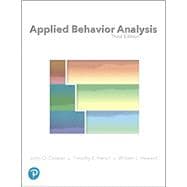This text provides an accurate, comprehensive, and contemporary description of applied behavior analysis in order to help readers acquire fundamental knowledge and skills
Applied Behavior Analysis provides a comprehensive, in-depth discussion of the field, offering a complete description of the principles and procedures for changing and analyzing socially important behavior. The 3rd Edition features coverage of advances in all three interrelated domains of the sciences of behavior–theoretical, basic research, and applied research–and two new chapters, Equivalence-based Instruction (Ch. 19) and Engineering Emergent Learning with Nonequivalence Relations (Ch. 20). It also includes updated and new content on topics such as negative reinforcement (Ch. 12), motivation (Ch. 16), verbal behavior (Ch. 18), functional behavioral assessment (Ch. 27), and ethics (Ch. 31). The content of the text is now connected to the BCBA® and BCABA® Behavior Analyst Task List, 5th Edition.








